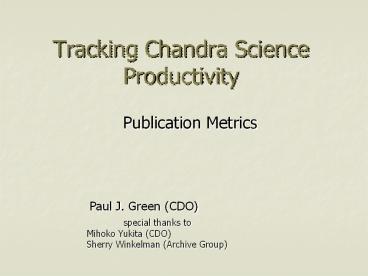Tracking Chandra Science Productivity - PowerPoint PPT Presentation
1 / 14
Title:
Tracking Chandra Science Productivity
Description:
Tracking Chandra Science Productivity. Publication Metrics. special thanks to. Mihoko Yukita (CDO) ... Database now current and backfilled to launch. ... – PowerPoint PPT presentation
Number of Views:16
Avg rating:3.0/5.0
Title: Tracking Chandra Science Productivity
1
Tracking Chandra Science Productivity
- Publication Metrics
Paul J. Green (CDO)
special thanks to Mihoko Yukita (CDO) Sherry
Winkelman (Archive Group)
2
Why Use Publications?
- An accepted measure of scientific productivity.
- Existing databases (e.g., ADS) allow trackable,
reproducible statistics. - Comparisons can be made to other observatories.
- What else is there? (News articles, Press
releases, funding)
3
Which Metrics?
- PhD dissertations
- papers
- citations
- pages
- including
- all publications
- refereed papers
- highly cited papers
- certain journals
4
Chandra Bibliography Database
See Archive Group presentation A. Rots
- Queries the ADS daily.
- Requires human scanning, culling, and
categorization. - Allows searching and statistics.
- Database now current and backfilled to launch.
- Plans for public search page soon, with links to
related data.
5
(No Transcript)
6
TOTALS BY YEAR
- Refereed only
- All proposal types GO, GTO, TOO, DDT
- (no CAL)
- Statistics through 18 Dec 2003
- Colored by paper category
7
S(Chandra Papers published that year)
Illustrates ramp-up in operations, archive size,
user familiarity
8
S(Citations in that year to all previous Chandra
Papers)
Same ramp-ups convolved with publication-to-citati
on delay.
9
MEANS BY YEAR
- Refereed, Category 1 only
- All proposal types GO, GTO, TOO, DDT
- (no CAL)
- Statistics through 18 Dec 2003
- Colored by paper category
- N.B. multiple countings
10
S(Papers published in each year)/ S(Targets used
in those Papers)
11
Comparisons
- Comparing to other scopes is tricky, e.g.,
- Whos the audience?
- Whats the purpose?
- How do you normalize paper or citation counts ?
- aperture area? (meaningless across
wavelengths) - program dollars? (space vs. ground!)
- photons?
- pointings!
- HST has 15x the citation impact of a 4-m
- ground-based telescope, but costs 100x as much.
- Benn Sanchez 2001, PASP, 113
12
Doctoral Theses
- Searching the dissertation abstracts
- http//lib.harvard.edu/e-resources/details/d/dissa
bst.html - as of 22 Dec 2003
- Year Chandra AND HST OR
- X-ray Hubble Space Telescope
- 1999 1 7
- 2000 5 10
- 2001 9 5
- 2002 9 6
- 2003 7 4
- TOTAL 31 32
13
Other Trends for Study
- The CXC Archive group database also allows study
of publication metrics by - journal (e.g., Nature citation rate 8x ApJ)
- most-cited papers
- observation type (DDT, TOO, LP, VLP)
- subject area
- PI institution
- proposal grade
- These all take effort!
14
Upcoming Public Metrics Page
- Simple statistics, updated monthly
- Omit inter-telescope comparisons
- Links to Chandra Bibliography Database































